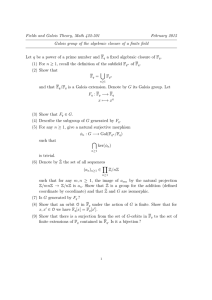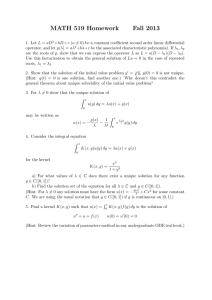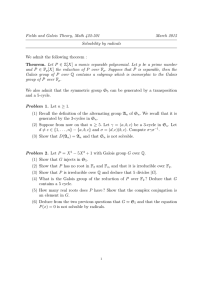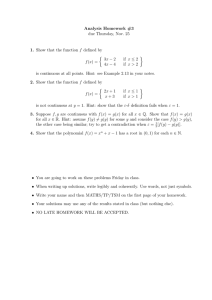Math 422/501: Problem set 10 (due 18/11/09) The trace
advertisement
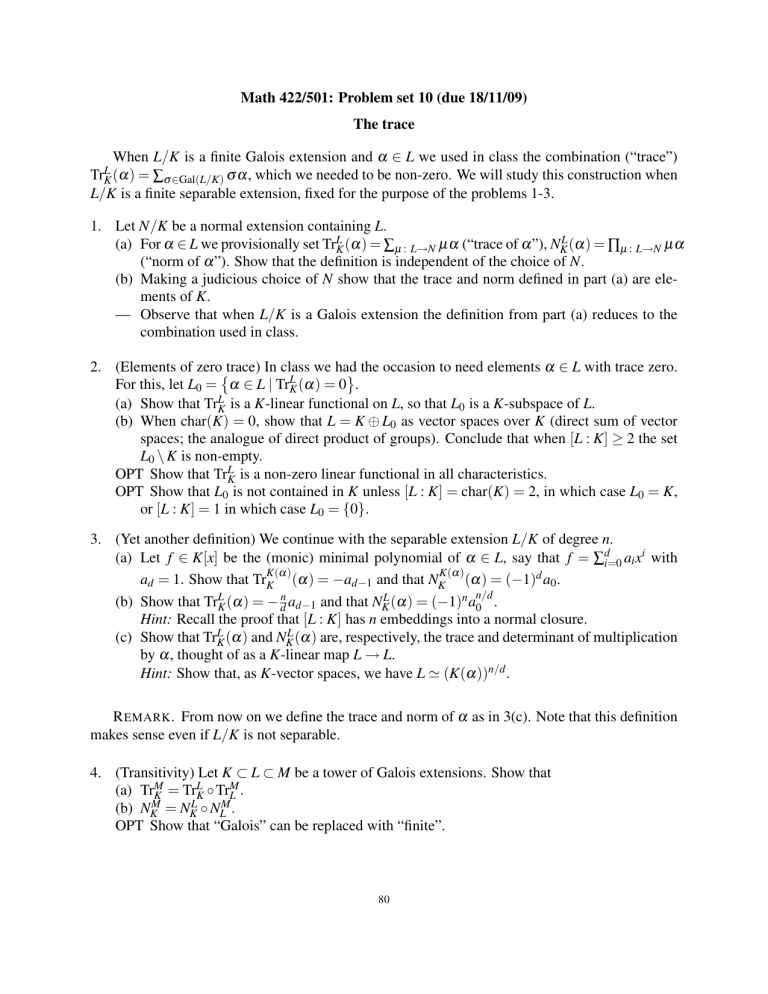
Math 422/501: Problem set 10 (due 18/11/09)
The trace
When L/K is a finite Galois extension and α ∈ L we used in class the combination (“trace”)
TrLK (α) = ∑σ ∈Gal(L/K) σ α, which we needed to be non-zero. We will study this construction when
L/K is a finite separable extension, fixed for the purpose of the problems 1-3.
1. Let N/K be a normal extension containing L.
(a) For α ∈ L we provisionally set TrLK (α) = ∑µ : L→N µα (“trace of α”), NKL (α) = ∏µ : L→N µα
(“norm of α”). Show that the definition is independent of the choice of N.
(b) Making a judicious choice of N show that the trace and norm defined in part (a) are elements of K.
— Observe that when L/K is a Galois extension the definition from part (a) reduces to the
combination used in class.
2. (Elements of zerotrace) In class we had the occasion to need elements α ∈ L with trace zero.
For this, let L0 = α ∈ L | TrLK (α) = 0 .
(a) Show that TrLK is a K-linear functional on L, so that L0 is a K-subspace of L.
(b) When char(K) = 0, show that L = K ⊕ L0 as vector spaces over K (direct sum of vector
spaces; the analogue of direct product of groups). Conclude that when [L : K] ≥ 2 the set
L0 \ K is non-empty.
OPT Show that TrLK is a non-zero linear functional in all characteristics.
OPT Show that L0 is not contained in K unless [L : K] = char(K) = 2, in which case L0 = K,
or [L : K] = 1 in which case L0 = {0}.
3. (Yet another definition) We continue with the separable extension L/K of degree n.
(a) Let f ∈ K[x] be the (monic) minimal polynomial of α ∈ L, say that f = ∑di=0 ai xi with
K(α)
K(α)
ad = 1. Show that TrK (α) = −ad−1 and that NK (α) = (−1)d a0 .
n/d
(b) Show that TrLK (α) = − dn ad−1 and that NKL (α) = (−1)n a0 .
Hint: Recall the proof that [L : K] has n embeddings into a normal closure.
(c) Show that TrLK (α) and NKL (α) are, respectively, the trace and determinant of multiplication
by α, thought of as a K-linear map L → L.
Hint: Show that, as K-vector spaces, we have L ' (K(α))n/d .
R EMARK . From now on we define the trace and norm of α as in 3(c). Note that this definition
makes sense even if L/K is not separable.
4. (Transitivity) Let K ⊂ L ⊂ M be a tower of Galois extensions. Show that
L
M
(a) TrM
K = TrK ◦ TrL .
(b) NKM = NKL ◦ NLM .
OPT Show that “Galois” can be replaced with “finite”.
80
Purely inseparable extensions
5. Let L/K be an purely inseparable algebraic extension of fields of characteristic p.
r
(a) For every α ∈ L show that there exists r ≥ 0 so that α p ∈ K. In fact, show that the minimal
r
r
polynomial of α is of the form x p − α p .
Hint: Consider the minimal polynomials of α and α p
— Conclude that when [L : K] is finite it is a power of p.
OPT When [L : K] is finite show that TrLK is identically zero.
Some examples
6. Solve the equation t 6 + 2t 5 − 5t 4 + 9t 3 − 5t 2 + 2t + 1 by radicals.
Hint: Try u = t + 1t .
7. Let K have characteristic zero and consider the system of equations over the field K(t):
2
x = y + t
y2 = z + t .
z2 = x + t
(a) Let (x, y, z) be a solution in a field extension of K(t). Show that x satisfies either x2 = x + t
or a certain sextic equation over K(t).
OPT Use a computer algebra system to verify that the sextic is relatively prime both to x2 −
x − t and to its own formal derivative.
(b) Show that the Galois group of the splitting field of the sextic preserves an equivalence
relation among its six roots.
Hint: Find an permutation of order 3 acting on the roots. This is visible in the original
system.
(c) Let {α, β , γ} be an equivalence class of roots, and let s(a, b, c) be a symmetric polynomial
in three variables. Show that s(α, β , γ) belongs to an extension of K(t) of degree 2 at most.
Hint: If s(α, β , γ) is a root of a quadratic, what shoudl the other root be? Show that the
coefficients of the putative quadratic are indeed invariant by the Galois group.
(d) Show that the system of equations can be solved by radicals.
Hint: For each equivalence class construct a cubic whose roots are the equivalence class
and whose coefficients lie in a radical extension.
OPT Show that knowing [K(t, x + y + z) : K(t)] = 2 where x, y, z are roots of the original system would have been enough.
OPTIONAL Let L = C(x) (the field of rational functions in variable) and for f ∈ L let (σ ( f )) (x) =
f ( 1x ), (τ( f )) (x) = f (1 − x).
(a) Show that σ , τ ∈ Aut(L) and that σ 2 = τ 2 = 1.
(b) Show that G = hσ , τi is a subgroup of order 6 of Aut(L) and find its isomorphism class.
(c) Let K = Fix(G). Find this field explicitely.
81
